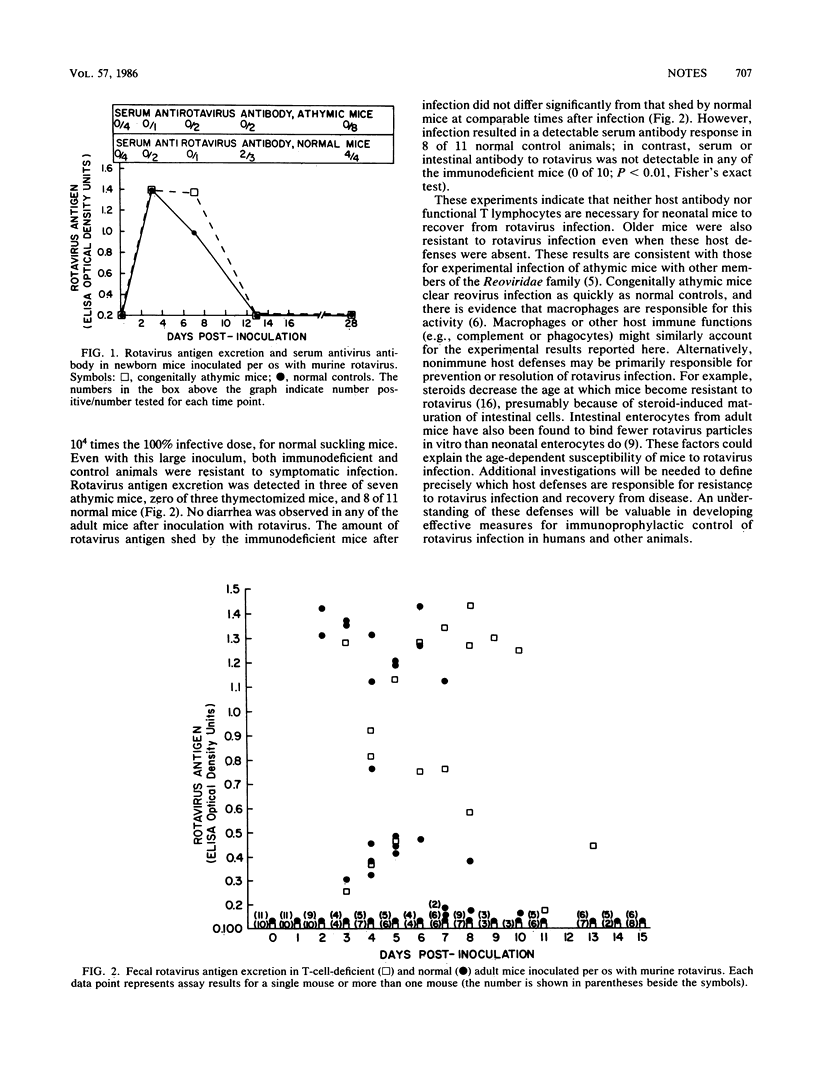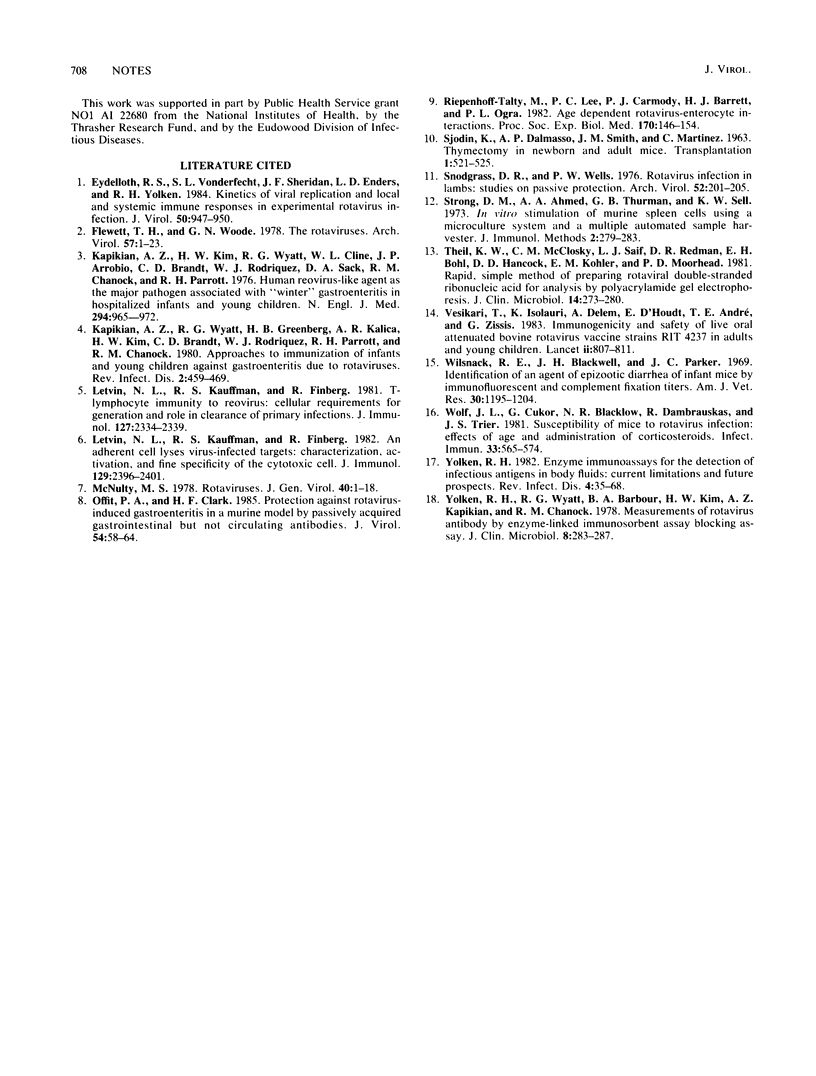Abstract
Rotaviruses are common causes of diarrhea in animals and humans. Little is known, however, about the components of the host response to these viruses. Rotavirus infection was studied in athymic mice experimentally infected with murine rotavirus. Neonatal T-cell-deficient mice experienced a self-limited gastrointestinal infection which was identical to that observed in age-matched immunocompetent mice. Adult T-cell-deficient seronegative mice and age-matched normal mice showed a similar extent of resistance to symptomatic rotavirus infection. In both cases, the infection was resolved without the generation of antirotavirus antibody. These studies indicate that host defense against murine rotavirus requires neither functional T-lymphocytes nor specific antiviral antibody.
Full text
PDF


Selected References
These references are in PubMed. This may not be the complete list of references from this article.
- Eydelloth R. S., Vonderfecht S. L., Sheridan J. F., Enders L. D., Yolken R. H. Kinetics of viral replication and local and systemic immune responses in experimental rotavirus infection. J Virol. 1984 Jun;50(3):947–950. doi: 10.1128/jvi.50.3.947-950.1984. [DOI] [PMC free article] [PubMed] [Google Scholar]
- Flewett T. H., Woode G. N. The rotaviruses. Arch Virol. 1978;57(1):1–23. doi: 10.1007/BF01315633. [DOI] [PMC free article] [PubMed] [Google Scholar]
- Kapikian A. Z., Kim H. W., Wyatt R. G., Cline W. L., Arrobio J. O., Brandt C. D., Rodriguez W. J., Sack D. A., Chanock R. M., Parrott R. H. Human reovirus-like agent as the major pathogen associated with "winter" gastroenteritis in hospitalized infants and young children. N Engl J Med. 1976 Apr 29;294(18):965–972. doi: 10.1056/NEJM197604292941801. [DOI] [PubMed] [Google Scholar]
- Kapikian A. Z., Wyatt R. G., Greenberg H. B., Kalica A. R., Kim H. W., Brandt C. D., Rodriguez W. J., Parrott R. H., Chanock R. M. Approaches to immunization of infants and young children against gastroenteritis due to rotaviruses. Rev Infect Dis. 1980 May-Jun;2(3):459–469. doi: 10.1093/clinids/2.3.459. [DOI] [PubMed] [Google Scholar]
- Letvin N. L., Kauffman R. S., Finberg R. An adherent cell lyses virus-infected targets: characterization, activation, and fine specificity of the cytotoxic cell. J Immunol. 1982 Dec;129(6):2396–2401. [PubMed] [Google Scholar]
- Letvin N. L., Kauffman R. S., Finberg R. T lymphocyte immunity to reovirus: cellular requirements for generation and role in clearance of primary infections. J Immunol. 1981 Dec;127(6):2334–2339. [PubMed] [Google Scholar]
- McNulty M. S. Rotaviruses. J Gen Virol. 1978 Jul;40(1):1–18. doi: 10.1099/0022-1317-40-1-1. [DOI] [PubMed] [Google Scholar]
- Offit P. A., Clark H. F. Protection against rotavirus-induced gastroenteritis in a murine model by passively acquired gastrointestinal but not circulating antibodies. J Virol. 1985 Apr;54(1):58–64. doi: 10.1128/jvi.54.1.58-64.1985. [DOI] [PMC free article] [PubMed] [Google Scholar]
- Riepenhoff-Talty M., Lee P. C., Carmody P. J., Barrett H. J., Ogra P. L. Age-dependent rotavirus-enterocyte interactions. Proc Soc Exp Biol Med. 1982 Jun;170(2):146–154. doi: 10.3181/00379727-170-41410. [DOI] [PubMed] [Google Scholar]
- SJODIN K., DALMASSO A. P., SMITH J. M., MARTINEZ C. THYMECTOMY IN NEWBORN AND ADULT MICE. Transplantation. 1963 Oct;1:521–525. doi: 10.1097/00007890-196301040-00011. [DOI] [PubMed] [Google Scholar]
- Snodgrass D. R., Wells P. W. Rotavirus infection in lambs: studies on passive protection. Arch Virol. 1976;52(3):201–205. doi: 10.1007/BF01348017. [DOI] [PubMed] [Google Scholar]
- Strong D. M., Ahmed A. A., Thurman G. B., Sell K. W. In vitro stimulation of murine spleen cells using a microculture system and a multiple automated sample harvester. J Immunol Methods. 1973 Apr;2(3):279–291. doi: 10.1016/0022-1759(73)90054-9. [DOI] [PubMed] [Google Scholar]
- Theil K. W., McCloskey C. M., Saif L. J., Redman D. R., Bohl E. H., Hancock D. D., Kohler E. M., Moorhead P. D. Rapid, simple method of preparing rotaviral double-stranded ribonucleic acid for analysis by polyacrylamide gel electrophoresis. J Clin Microbiol. 1981 Sep;14(3):273–280. doi: 10.1128/jcm.14.3.273-280.1981. [DOI] [PMC free article] [PubMed] [Google Scholar]
- Vesikari T., Isolauri E., Delem A., D'Hondt E., André F. E., Zissis G. Immunogenicity and safety of live oral attenuated bovine rotavirus vaccine strain RIT 4237 in adults and young children. Lancet. 1983 Oct 8;2(8354):807–811. doi: 10.1016/s0140-6736(83)90734-1. [DOI] [PubMed] [Google Scholar]
- Wilsnack R. E., Blackwell J. H., Parker J. C. Identification of an agent of epizootic diarrhea of infant mice by immunofluorescent and complement-fixation tests. Am J Vet Res. 1969 Jul;30(7):1195–1204. [PubMed] [Google Scholar]
- Wolf J. L., Cukor G., Blacklow N. R., Dambrauskas R., Trier J. S. Susceptibility of mice to rotavirus infection: effects of age and administration of corticosteroids. Infect Immun. 1981 Aug;33(2):565–574. doi: 10.1128/iai.33.2.565-574.1981. [DOI] [PMC free article] [PubMed] [Google Scholar]
- Yolken R. H. Enzyme immunoassays for the detection of infectious antigens in body fluids: current limitations and future prospects. Rev Infect Dis. 1982 Jan-Feb;4(1):35–68. doi: 10.1093/clinids/4.1.35. [DOI] [PubMed] [Google Scholar]
- Yolken R. H., Wyatt R. G., Barbour B. A., Kim H. W., Kapikian A. Z., Chanock R. M. Measurement of rotavirus antibody by an enzyme-linked immunosorbent assay blocking assay. J Clin Microbiol. 1978 Sep;8(3):283–287. doi: 10.1128/jcm.8.3.283-287.1978. [DOI] [PMC free article] [PubMed] [Google Scholar]


